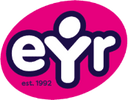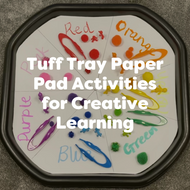Tuff Tray Paper Pad Activities for Creative Learning
Posted by EYR Team on 10th Aug 2021
read more
It all starts with a blank canvas and a bit of inspiration… The first of its kind, our exclusive Tuff Tray Paper Pad is the perfect resource for inspiring creativity as it provides the ideal base for a range of different activities, from art and craft projects to curricular learning activities and everything in between! In this blog post, we will delve into 5 engaging activities that you can easily recreate at home with the little ones with few resources, read on for more!
Phonics
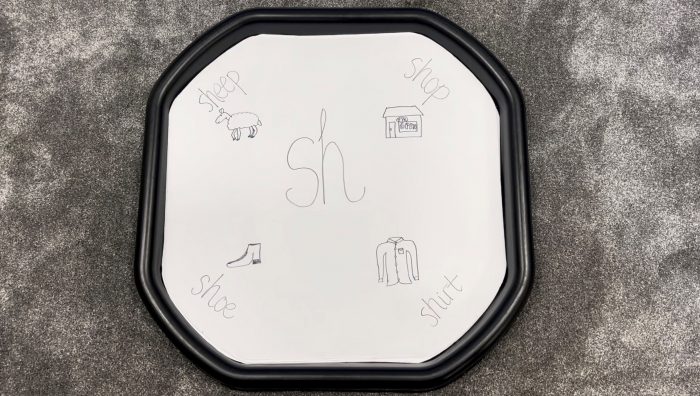
Phonics is a method of teaching children to read words using the connection between sounds and spoken language. It’s vital in helping them understand words and is one of the most crucial elements of a child’s early education. One of the main difficulties children face while learning to read using phonics is the difference between letters and sounds. The paper pad provides an effective way to showcase visual representations of how phonemes within spoken words sound.
Start by choosing a phoneme based on your child’s level, for example, p, a, ar, sh, th and with your little ones, write the letters on the paper pad. See how these letters sound on their own and try to think of any examples of words where this phoneme exists.
Depending on your child’s development you can then explore various words, starting with ‘CVC’ words and working upwards to longer, more complex words. Asking your child to draw pictures of these words like cat, cow, car etc. will solidify their memory of the phoneme and how it sounds.
To develop their learning even more, why not try writing various words and pictures and see if your child can match the correct word or image to the phoneme. This activity offers a great way to further consolidate their linguistic learning and supports language development.
Rainbow sorting
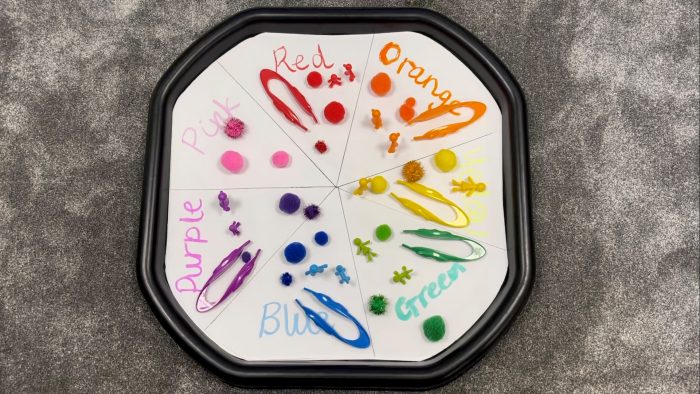
Classifying and sorting objects is a brilliant way to help children develop a range of thinking skills and lays the foundation for future problem-solving. When asked to sort objects, children are required to classify them according to similarities and differences and determine if an object has more or less of a certain attribute.
Sorting is an activity that doesn’t have to be restricted by expensive resources. Using the Tuff Tray Paper Pad and objects gathered from around your house, you can easily put together a series of fun sorting tasks for children to get stuck into.
Start by dividing up sections on your paper pad and give each section a title for example with colour sorting, titles could include red, yellow, blue, green etc. Then give children a pile of objects and see if they can correctly sort them into the relevant section. An activity like this is a brilliant way to encourage colour recognition, develop fine motor skills and can be used to support counting and early maths. As well as rainbow sorting why not try sorting objects by size, quantity or letters? Simply tear back a sheet on the paper pad to start a new activity.
Practising pencil control
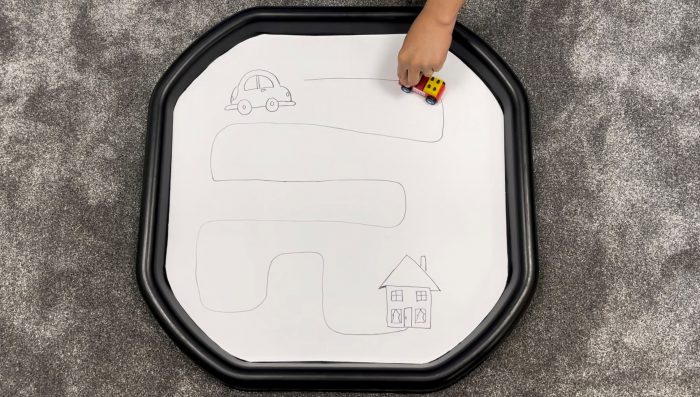
Holding a pen or pencil properly requires strong finger and hand muscles as well as dexterity. The ability or inability to hold a pencil correctly can significantly affect a child’s speed and fluency which in turn affects their attitude to learning and eventually their academic achievement as well as motor/joint development.
According to experts, 3 years old is the ideal age to start learning correct pencil grip and a great way to do this is through art classes, drawing and following patterns. The Tuff Tray Paper Pad naturally gives rise to several art opportunities and mark making activities which are perfect to improve pencil control and develop fine motor skills. One such activity is by drawing mazes and asking children to follow the line through the maze onto the other side.
Using mazes to practice pencil control is an activity that can be modified for any age. Children who are aged 3+ years will be holding a pencil more comfortably and can be encouraged to follow the line from the starting point right to the end of the line. Younger children can be asked to do the same activity but with slight modifications, for example, children aged 1-2 may find it easier to hold a larger object like a toy car to follow the line. This is something you can test with your children and slowly build up the level of difficulty with different objects and more complex mazes.
Symmetry painting
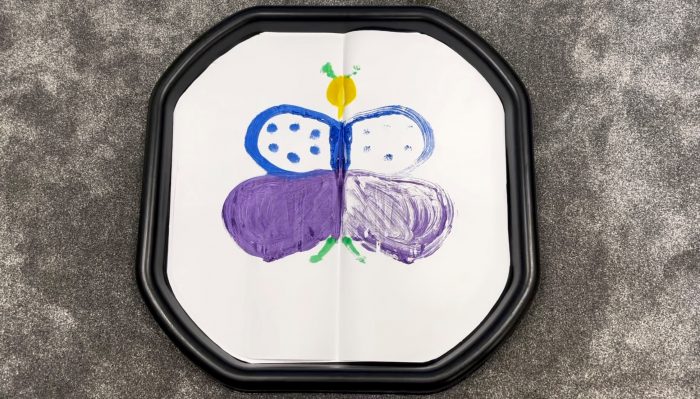
Spatial reasoning is all about understanding how objects and the things around us move and interact in a 3-dimensional world. Children engage spatially all the time, from a baby reaching for a toy to a 6 year old deciding how much paper to cut out to wrap a present. Research has consistently shown the importance of early spatial reasoning in later mathematical achievement.
Within spatial reasoning are 5 core aspects that spatial representation falls under. Spatial representation refers to creating mental images, understanding perspective and how things will look from different viewpoints.
One great way to build on this concept is through symmetry painting. The Tuff Tray Paper Pad provides the perfect base to carry out this activity. Symmetry painting requires children to develop an idea (i.e. what are they going to paint), create a strategy (i.e. what will they paint on one side of the paper to make the final result look like a butterfly) and action their plan.
To do this simply fold a sheet of the paper pad in half and use the fold line as your centre. Ask children to paint on one side explaining that when you fold the paper in half again, the paint will transfer onto the other side creating a mirror image. Try asking questions during this activity such as “if you put a bit of paint here, what will happen to the end result”, “how can you give the butterfly two antennas?” To further develop this concept, why not try this activity in a group? Task the children with creating a design and see if they can come up with an idea and action their plan effectively as a group.
Block printing
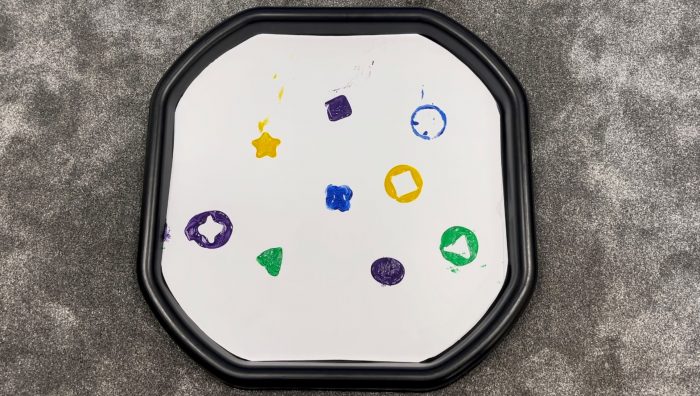
Shape and measure is another important aspect of mathematical development. Children need to learn about shapes in their environment and the concept of measure to gain spatial awareness and develop mathematical understanding.
A great way to explore shape is through printing! This creative activity is a fun way to get children talking about shapes. You can use toy blocks or even potatoes cut into simple shapes like squares, circles and triangles.
Using the Tuff Tray Paper Pad within a tuff tray means that the messy play activities are confined to the raised sides of the tuff tray, limiting the amount of mess. The pad itself offers a large blank canvas that provides far more space than your typical A4 piece of paper.
When the finished pictures are dry, try and engage children in a conversation about the shapes and maybe try asking some of the following or similar questions:
- Which is the yellow square?
- What is the yellow shape called?
- How many circles are there?
- Which is the biggest shape?
- Which has the most sides?
- How many blue shapes are there?
Summary
The best way to support early learning is through the use of open-ended, versatile resources as they encourage children to develop their creativity and imagination while building on a range of important skills. Our paper pad is the perfect accompaniment to our highly sought after tuff tray as it can be incorporated into all areas of learning and play. Shop our Tuff Tray Paper Pad now and explore the range of possibilities it can offer for learning, development and creativity!
